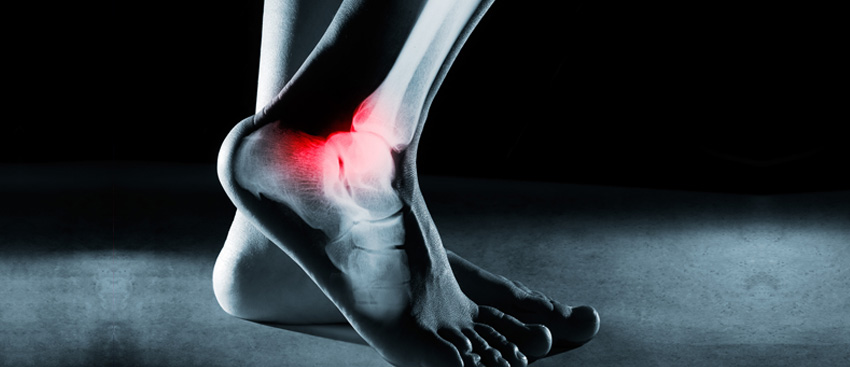
The foot and ankle is a complex structure. The human foot and ankle is a strong structure which contains exactly 26 bones, 33 joints. Foot and ankle injuries are common in sports like running, tennis, football, baseball and soccer. Sprained ankle is most common type of ankle injury.
Foot and ankle physical therapy involves diagnosis, treatment planning and rehabilitation for conditions of the foot, ankle and shin, including post-surgical or conservatively managed patients.
The Ankle:
The ankle joint is where the two lower leg bones tibia and fibula meets talus at bottom. This joint allows the ankle to flex and extend. There is a second joint in the ankle between the talus and the calcareous called subtalar joint. This joint allows the foot to move inward and outward. Foot is divided in three part hind foot, mid foot and fore foot. These all are held together with tendons, ligaments and muscles.
Causes and Conditions:
Listed are the common causes and conditions of ankle and foot pain.
Ankle Sprain Sprain is also known as twisted ankle, sprained ankle. Ankle Sprain happens when the ligaments of the ankle are stretched more then their capacity during sport, walking, running, jumping. It can be partially torn or completely torn during an injury depend upon force. Most common ankle sprain is lateral (outer side) ankle sprain. Acute ankle sprains are treated with rest, ice, compression, elevation. Patient will need physical therapy to regain his strength and pain free activity of daily living.
Plantar Fasciitis is an inflammation of planter fascia, connective tissue on the sole of the foot. It is very common condition in which patient complains of pain under heel getting out of bed early in the morning and getting up after sitting for a while. It is caused by overuse of planter fascia. It is common in people who does lot of standing, walking. Footwear also plays major role in planter fascistic. Most of the patient gets better with conservative treatment including shots, physical therapy.
Achilles Tendinitis occurs when there is pain and swelling in the area at the back of the heel, caused by inflammation of the Achilles tendon. It is caused by overuse and it is common in recreational athletes, walker and runner. Because the Achilles tendon has poor blood supply, this injury can be slow to heal. It is normally treated conservatively with rest, ice, footwear modification and physical therapy.
Morton’s neuroma is also known as metatarsalgia, planter neuroma, planter nerve lesion. Usually patient complains of pain swelling in ball of their foot it is more common between 2nd, 3rd, 4th digit. Patient may complain of burning and tingling pain. It is treated conservatively with shots, medication and physical therapy. If all conservative method fails patient may be advised for surgical option.
Tarsal Tunnel Syndrome is a nerve entrapment injury. Its when tibial nerve get compressed in tarsal tunnel around ankle. Patient with this condition will have pain inside and outer side of foot also will complain of numbness. Pain might be worst in night. It is treated conservatively with shots, medication and physical therapy. If all conservative method fails patient may be advised for surgical option.
Achilles Tendon Rupture Rupture is when there is a full thickness tear of the Achilles tendon connecting the calf muscle to the heel bone. This injury causes sudden pain in the back the ankle, makes patient unsteady and fall in complete rupture. Ruptures can be accompanied by an audible “pop” or a “snap” sound. In complete rupture surgery is indicated. Partial tendon rupture may be treated non-surgically.
Stress Fracture is a hairline fracture, or a very small crack, that occurs in the bones of the foot, usually the fifth metatarsals on the outer side of the foot or the tibia in the lower leg. It is very common in atheletes, dancers. Usually this injury involves generalized pain in the foot with weight bearing and associated with swelling. Most of the stress fractures treated with immobilization followed by physical therapy to regain range and strength.
Fractures are common around ankle and foot. Most common fractures are malleolar (lower end of tibia and fibula) fracture, Calcaneal fracture, Talus fracture and Metatarsal fracture. Most fractures are treated with immobilization or with surgical intervention. Patients will need physical therapy post immobilization to avoid post surgical complications.
What can we do if you have ankle or foot pain?
At New Age Physical Therapy, your therapist will perform a detailed assessment to determine the exact cause of your symptoms and prescribe the best course of treatment for your injury. This treatment may include one or more of the following:
Modalities for pain relief including electrical Stimulation, Ultrasound, heat and ice.
Massage to promote soft tissue healing and break up scar tissue.
Manual therapy to improve movement in your ankle joints.
An exercise program including strengthening and stretching.
A specific plan to help you to avoid ankle injuries in the future.


